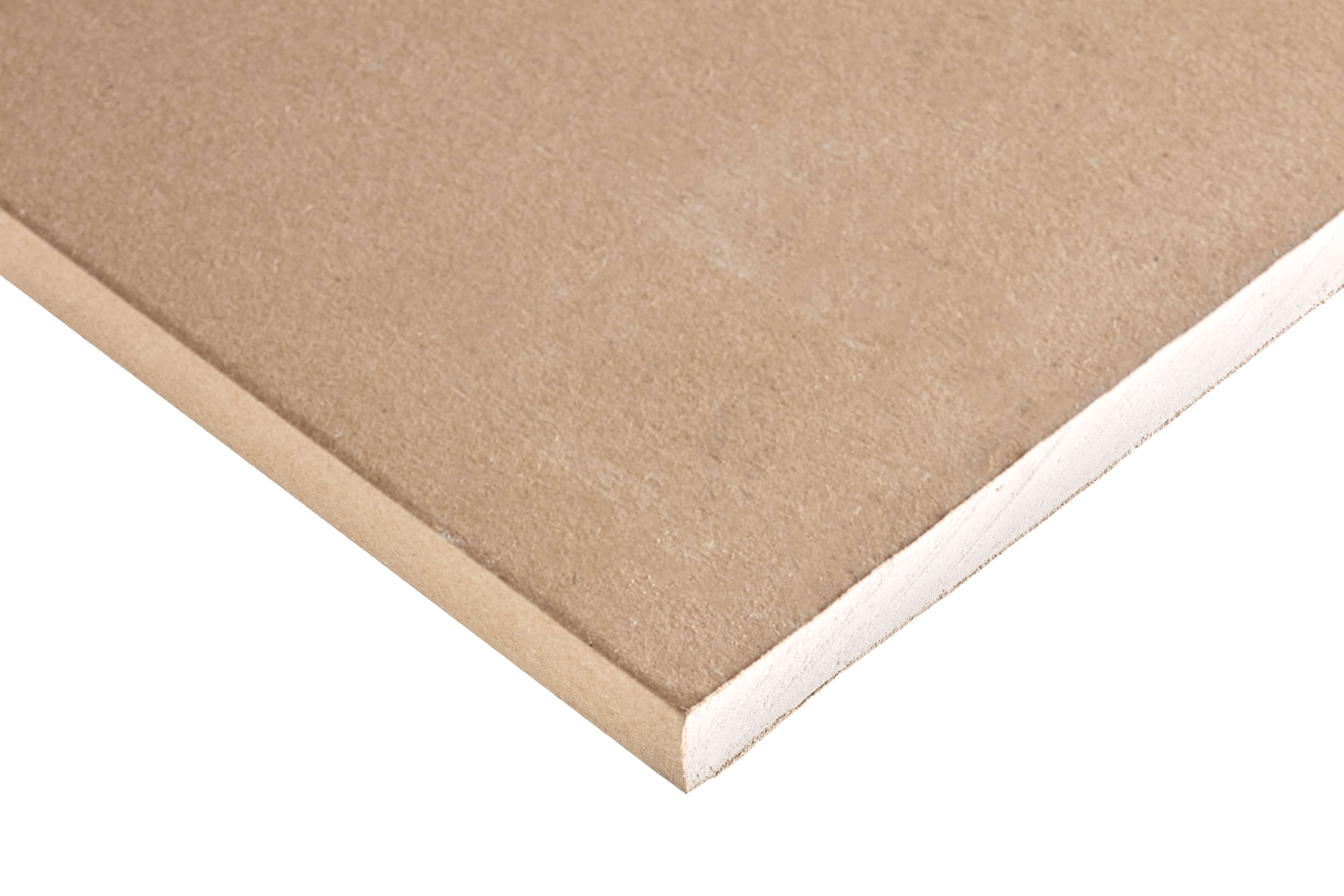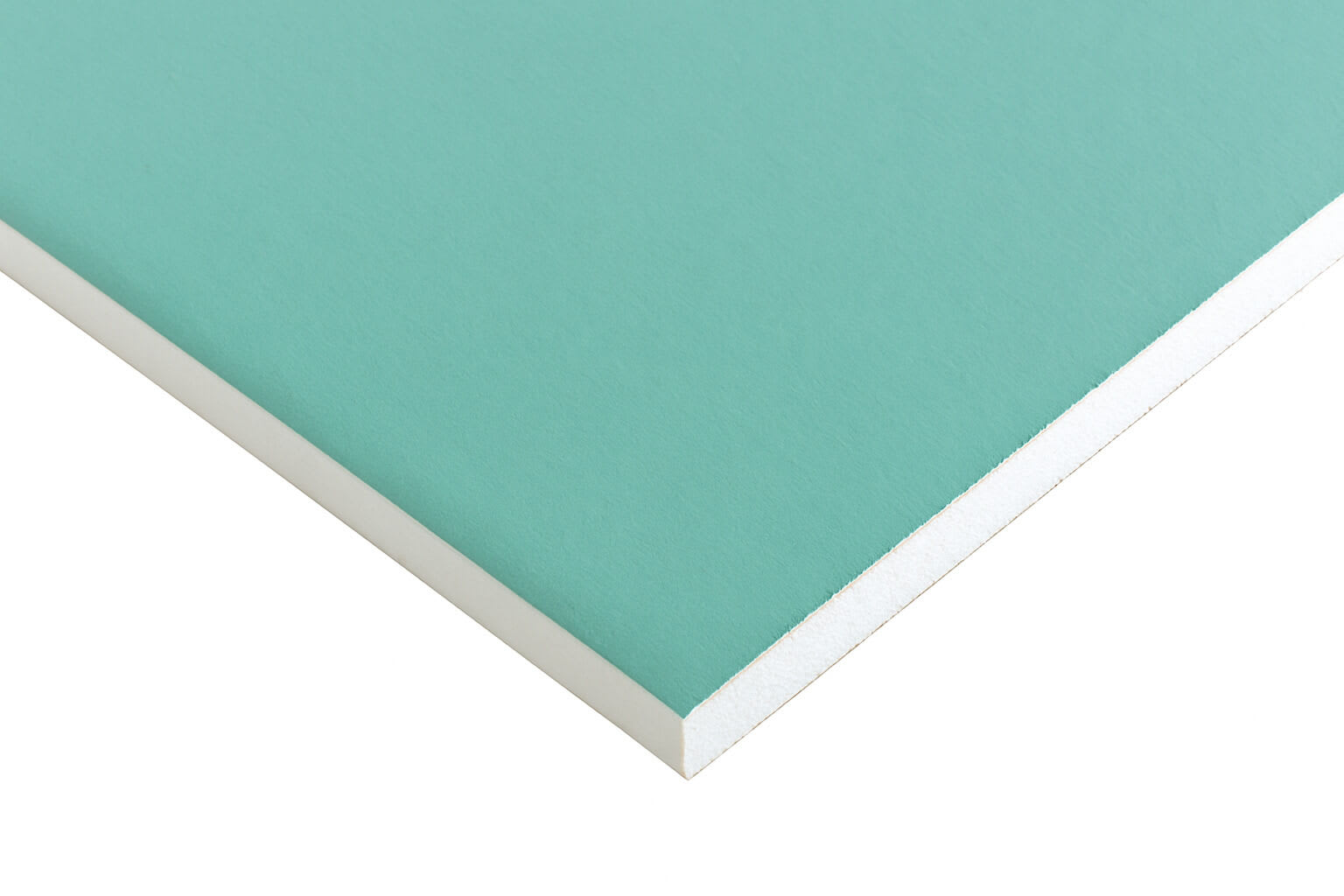Square Edge Plasterboard
(11 Products)Square edge plasterboard is characterised by its perfectly straight and uniform edges on all four sides. Unlike its tapered edge counterpart, which features recessed long edges, square edge boards maintain a consistent thickness right up to the very edge.
This distinct profile makes it the preferred choice for specific applications where either a full skim coat of traditional plaster will be applied over the entire surface, or where the joints between boards will be entirely concealed by battens, architraves, or other decorative trims.
What Is Square Edge Plasterboard?
Square-edge (SE) plasterboard is a gypsum core panel faced on both sides with paper, whose long edges are cut perfectly straight rather than tapered or bevelled.
When two boards meet they form a “butt joint” that sits flush with the surface of the sheet.
Applications
- Traditional Plaster Skimming: This is its most common and ideal application. Square edge boards provide a perfect, flat substrate for applying a full 2-3mm skim coat of gypsum finishing plaster across the entire wall or ceiling surface, resulting in a classic, hard, and smooth plaster finish.
- Behind Decorative Battens/Strapping: Often used when a decorative finish involves timber battens, panelling, or strapping that will cover the joints, eliminating the need for taping and jointing.
- Concealed Areas: Suitable for areas that will not be seen or directly decorated, such as within lofts, behind fitted furniture, or in service voids, where a seamless joint finish is not a priority.
- Tiling Substrate: Can be used as a substrate for tiling in dry areas where a full, rigid, flat surface is needed. (Note: Moisture-resistant square edge plasterboard should be used in damp areas).
- Encasing Structural Elements: Employed to box in structural beams, columns, or pipework, particularly when the intention is to fully plaster these elements or clad them with another material that will conceal the board joints.
Benefits
- Ideal for Skim Plastering: Its uniform thickness across the entire board provides a consistent base for the application of a full skim coat of traditional plaster.
- Uniform Surface for Full Covering: When the entire surface is to be covered by another material (e.g., large format tiles, timber cladding, or decorative panels), the flat, non-tapered edges ensure a consistent substrate, simplifying the installation of the overlying material.
- Concealed Joints: Particularly useful in applications where joints will not be taped and filled, but rather hidden by architectural features such as battens, decorative strapping, beadings, or even where the entire wall will be wallpapered with a robust paper.
- Structural Versatility: Provides a strong and stable lining for internal partition walls, ceilings, and encasements. Its rigidity contributes to the overall stability of the framed structure it is attached to.
- Cost-Effective Base: As a standard plasterboard type, it offers an economical solution when the intention is to apply a full plaster finish or to cover the joints by other means.
- Variety in Performance: Like tapered edge boards, square edge variants are available in different performance types (e.g., fire-resistant, moisture-resistant, acoustic, impact-resistant), allowing for specialised applications while retaining the square edge profile.
Finishing Methods
Two-coat skim (traditional method)
- Bed 100 mm scrim tape over every butt joint and external corner.
- Apply a tight coat of gypsum finish plaster, key it, allow to firm.
- Lay a second thin coat, trowel flat and polish.
Direct decoration
If the substrate tolerance allows, joints can be filled with a setting compound, sanded, and the board sealed with a proprietary drywall primer before painting. This approach is common on small utility rooms or temporary partitions but requires meticulous joint filling to hide butt joints.
Key difference from tapered-edge: SE boards must be plastered or fully filled and sanded; they cannot accept a simple tape-and-joint finish without feathering because the joint sits proud rather than recessed.
Frequently Asked Square Edge Plasterboard Questions
Can I Paint Directly Onto Square Edge Plasterboard Without Skimming?
While technically possible, directly painting standard square edge plasterboard without a skim coat is generally not recommended for achieving a high-quality, professional finish.
The primary reason is that all four edges of square edge boards are cut square, meaning there is no recess to accommodate jointing compound and tape without creating a noticeable ridge. If you attempt to tape and fill these joints, they will almost certainly be visible as humps or variations in texture under paint, especially with lighter colours or critical lighting.
Furthermore, the paper face and any jointed areas will have different porosities, leading to "ghosting" or "flashing" where paint absorbs unevenly. For a seamless, paint-ready surface, square edge plasterboard is best utilised as a substrate for a full plaster skim, or where the joints will be deliberately covered by battens, cladding, or other architectural features.
Is Square Edge Plasterboard Heavier Or Harder To Handle Than Tapered Edge?
Generally, standard square edge plasterboard of the same thickness and dimensions will have a very similar weight to its tapered edge counterpart.
The slight difference in gypsum removed for the taper is negligible in terms of overall board weight. Therefore, the handling difficulty primarily stems from its physical size and rigidity rather than a significant weight difference due to the edge profile.
Both types of plasterboard require sufficient handling techniques, such as carrying vertically on edge and using two people for larger sheets, to prevent damage like snapping or bending, and to ensure installer safety.
For ceiling installations, using a plasterboard lift is highly recommended for both square and tapered edge boards of any significant size.
Is SE Plasterboard More Expensive Than Tapered?
The board price is similar; labour and finishing materials are the cost drivers - skim coating a whole wall is dearer than taping a recessed joint.







.jpg)





